|
|
|
|
|
|
 |
Z'Basel an mim
Rhi -
Erinnerung an Basel -
Remembrance of Basel
|
|
|
zurück
zur
Gedicht-
übersicht |
mit den entspr. zeitgenössischen Stadtansichten von Emanuel Büchel with the corresponding contemporary city views by Emanuel Büchel |
|
|
|
Z'Basel an mim Rhi,
jo dört möchti si!
Weiht nit d'Luft so mild
und lau,
und der Himmel isch so blau
an mim liebe Rhi.
Im Vordergrund
Kleinbasel,
jenseits des Rheins Großbasel.
|
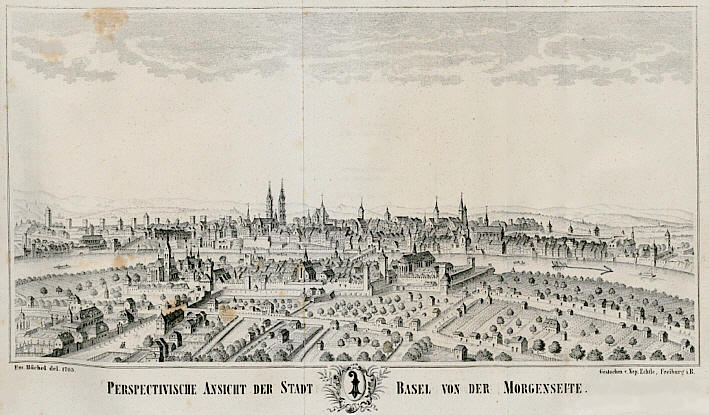 |
|
To Basel on my Rhine
yes, I would like to be there!
Doesn't the air blow so mild and balmy
and the sky is so blue
on my dear Rhine.
In the foreground Kleinbasel,
on the other side of the Rhine Großbasel. |
|
|
|
In der Münsterschuel,
uf mim herte Stuehl,
magi zwor jetz nüt meh ha,
d'Töpli stöhn mer nümmen a
in der Basler Schuel.
(Münsterschuel =
das
letzte
Gebäude
an
der rechten Platzseite)
Im Schuljahr 1772/73 besuchte
Hebel eine Klasse der Münsterschule.
Töpli = Tatzen =
Schläge auf die Handflächen eines Schülers. |
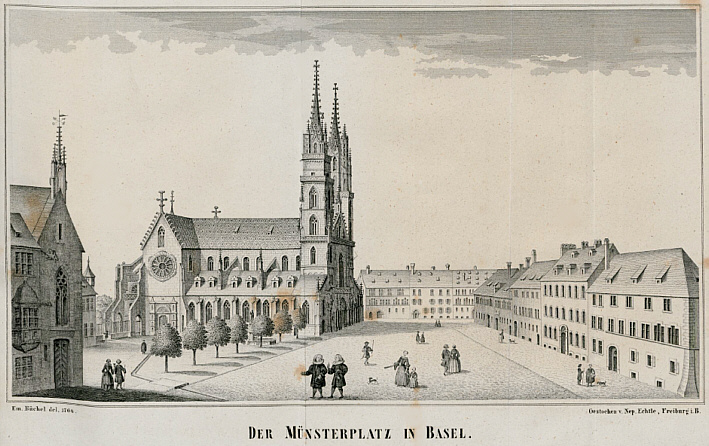 |
|
In the cathedral school,
on my hard chair,
I no longer like to be there,
my knees no longer stand up
in the Basel school.
(Münsterschuel = the last building on the right-hand side of the square)
In the school year 1772/73,
Hebel attended a class at the cathedral school.
Töpli = paws = Cane strokes to the palms of a pupil's hands. |
| |
|
Aber uf der Pfalz
alle Lüte gfallt's.
O, wie wechsle Berg und Tal,
Land und Wasser überal,
vor der Basler Pfalz!
Die Pfalz = eine
Aussichtsterrasse
vor dem Münster hoch
über dem
Rhein gelegen (im
Zentrum des
Bildes)
mit einem weiten Panorama-Blick von
den Vogesen über Oberrhein- und
Wiesental, den Schwarzwald und
den
Hochrhein bis zum Schweizer Jura. |
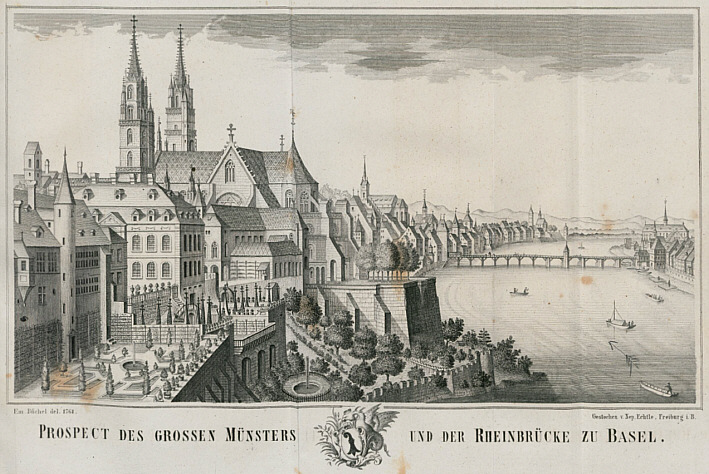 |
|
But on the Palatinate
everyone likes it.
Oh, how the mountains and valleys change,
Land and water everywhere,
in front of the Palatinate!
The
Palatinate = a viewing terrace
in front of the cathedral high above the Rhine (in the center of the
picture) with a wide panoramic view from the Vosges mountains over the
Upper Rhine and Wiesental valleys, the Black Forest and the High Rhine
to the Swiss Jura. |
| |
|
Uf der breite Bruck,
für si hi und zruck,
nei, was sieht me Here stoh,
nei, was sieht me Jumpfere
goh,
uf der Basler Bruck.
Um 1525 erbaut mit 5
Steinpfeilern - bis zum Capelljoch - und 8 Holzpfeilern. 1457 folgt der 6.
Steinpfeiler, das Bärenfelser Joch (ungefähr in der Flußmitte), der
einen Holzpfeiler ersetzte.
In dieser, bis 1903 unveränderten Gestalt sah sie auch Hebel während
seiner Basler Jahre. |
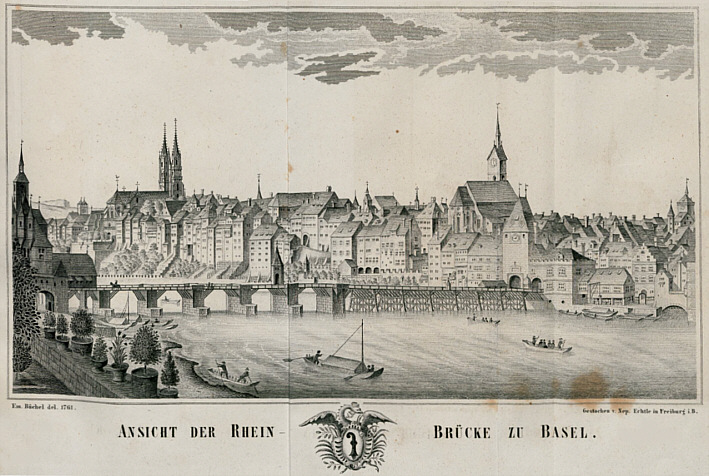 |
|
On the wide bridge,
forwards there and back,
no, what do you see gentlemen standing,
no, what do you see maidens walking,
on the Basel bridge.
Built around 1525 with 5 stone pillars - up to the Capelljoch - and 8
wooden pillars. The 6th stone pillar, the Bärenfelser Joch (roughly in
the middle of the river), followed in 1457, replacing a wooden pillar.
Hebel also saw it in this form, unchanged until 1903, during his years
in Basel. |
| |
|
Eis isch nümme do;
wo isch's ane cho?
's Scholers Nase, weie
weh,
git der Bruck kei Schatte meh.
Wo bisch ane cho?
Der Buchbinder Augustin Scholer wohnte im Gebäude des
heutigen Restaurant Spillmann am Großbasler Ende der Rheinbrücke,
war ein stadtbekanntes Original und hatte eine riesige Nase.
Der Sage nach war er genauso schwer aus seinem Haus herauszulocken wie
Diogenes aus seiner Tonne. |
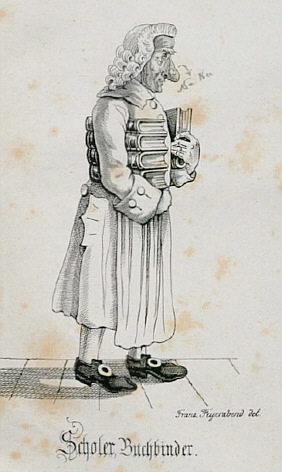 |
|
One is no longer there;
where has it gone?
the Scholer's nose, oh my,
no longer gives the bridge a shadow.
Where have you gone?
The bookbinder Augustin Scholer lived in the building of today's
Restaurant Spillmann at the Großbasel end of the Rhinebridge, was a
well-known city original and had a huge nose.
Legend has it that he was just as difficult to lure out of his house as
Diogenes was to get out of his barrel. |
| |
|
Wie ne freie Spatz,
uffem Petersplatz,
fliegi um, und 's wird mer
wohl,
wie im Buebekamisol
uffem Petersplatz.
|
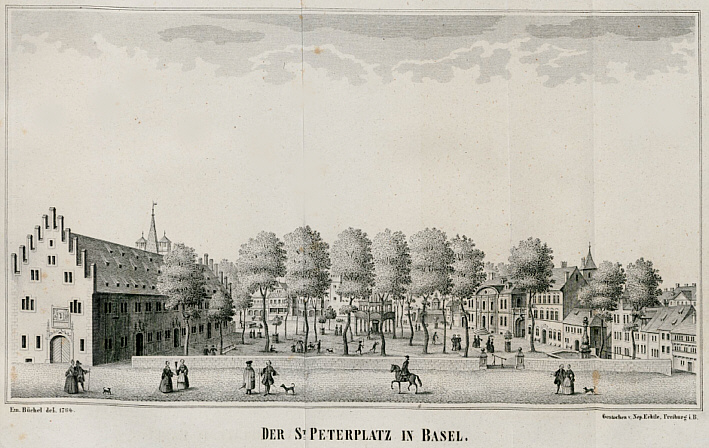 |
|
Like a free sparrow,
in St. Peter's Square,
I fly around, and I'm becoming happy,
like in the boys camisol
on St. Peter's Square. |
| |
|
Uf der grüene
Schanz,
in der Sunne
Glanz,
woni Sinn und Auge ha,
lacht's mi nit so lieblig a,
bis go Sante Hans.
Sante Hans =
St. Johanns-Vorstadt
Blick in Richtung Peterskirche
(im Zentrum des Bildes),
die Stadtmauer liegt im Rücken des Betrachters. |
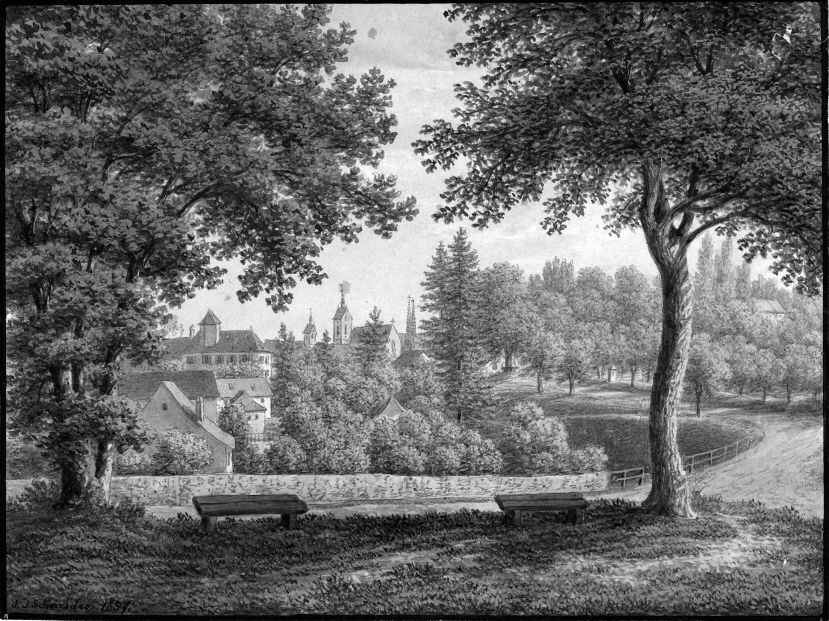 |
|
On the green redout,
in the sun glow,
where I have sense and eyes,
nothing smiles at me so sweetly,
Up to Sante Hans.
Sante Hans =
St. Johanns-Suburb
View in the direction of St. Peter's Church
(in the center of the picture),
the city wall is behind the viewer. |
| |
|
's Seilers
Rädli springt;
los, der
Vogel singt.
Summervögeli iung und froh
ziehn de
blaue Blueme no.
Alles singt
und springt.
(Der Seiler hatte seine Anlage zur
Herstellung von Seilen entweder im Petersgraben, der zu Hebels Zeiten
schon als Strasse benützt, aber noch als Graben ausgebildet war, oder
ausserhalb der zweiten Stadtmauer vor der Petersschanze (PS) im Stadtgraben zwischen dem Turm "Lug
ins Land" und der "Neuen Vorstadt" (heutige Klingelberg/
Schanzenstrasse).
|
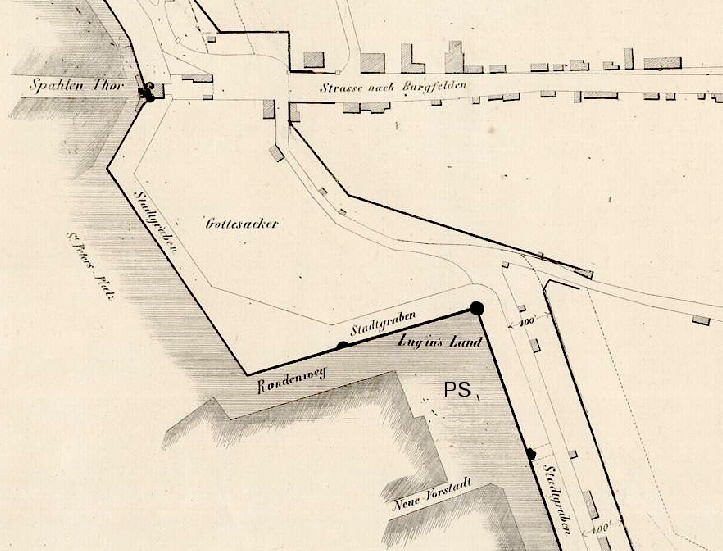 |
|
the rope makers wheel jumps;
listen, the bird sings.
Butterflies young and happy
follow the blue flowers.
Everything sings and jumps.
(The rope maker had his plant for making ropes either in the
Petersgraben, which was already used as a street in Hebel's time but was
still a moat, or outside the second city wall in front of the
Petersschanze (PS) in the 'Stadtgraben' between the “Lug ins Land” tower
and the “Neue Vorstadt” (today's Klingelberg/ Schanzenstrasse). |
| |
|
Und e bravi Frau
wohnt dört
ussen au.
„Gunnich Gott e frohe Muet!
Nehmich Gott in treui Huet,
liebi Basler Frau!"
„An Frau Meville" - die "Basler Frau".
Ihr - korrekt Susanna Miville-Kolb -
ist „Z'Basel
an mim Rhi" gewidmet. |
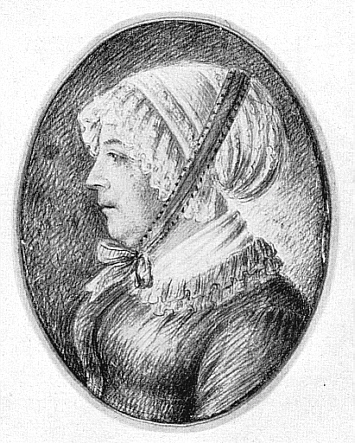
|
|
And a good woman
lives out there too.
“God grant you joyful courage!
May God take you into his faithful guard,
dear Basel woman!”
"To Mrs. Meville" - the "Basel woman".
Z'Basel an mim Rhi" is dedicated to her -
correctly Susanna Miville-Kolb. |
| |
|
|
|
|
| |
|
Die o. a. Stadtansichten wurden von
Emanuel Büchel von 1761 bis 1768 gezeichnet; diverse Quellen, alle gemeinfrei.
Der 'Buchbinder Scholer' stammt von Franz Feyerabend (Jahr unbek.).
Die Petersschanze: Staatsarchiv Basel, Bild Schn. 186, gemeinfrei.
Ausschnitt a. d. Plan "Umfang der Stadt Basel": Unibibliothek Basel VB A2:2:34
The above city views were drawn by Emanuel Büchel from 1761 to 1768;
various sources, all in the public domain.
The “Buchbinder Scholer” is by Franz Feyerabend (year unknown).
St Peter's Lair: Basel State Archives, image no. 186, in the public
domain.
Detail of the plan ‘Umfang der Stadt Basel’: Unibibliothek Basel VB
A2:2:34
|
| |
|
Emanuel Büchel (* 18. August 1705 in
Basel; † 24. September 1775 ebenda) war ein
Schweizer Bäcker, Zeichner, Topograph und Aquarellist
und zeichnete vor
allem die
Botanik und Ansichten seiner Heimatgegend Basel.
Emanuel Büchel (* 18 August 1705 in
Basel; † 24 September 1775 in Basel) was a Swiss baker, draughtsman,
topographer and watercolourist
and mainly drew botany and views of his home region of Basel.
|
| |
|
|
|
|
| |

zurück
zur
Gedicht-
übersicht
|
|
|
nach
oben
|